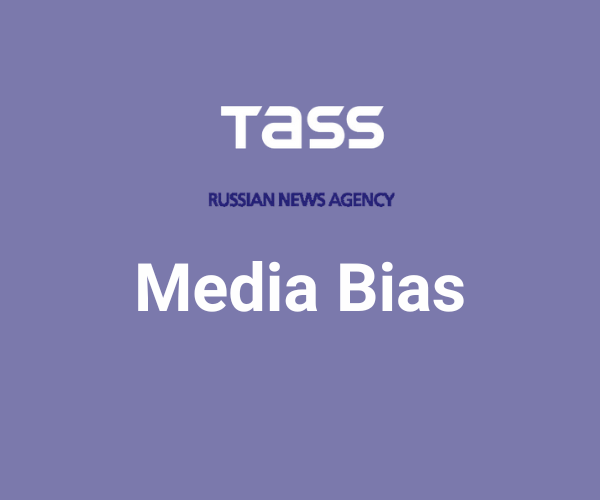
The Russian News Agency, abbreviated TASS, is a Russian-owned state news agency and the largest one in the country. While TASS is considered Russian-state media, its audience is not limited to Russia. Their website, tass.com, is free to access worldwide and averages over a million visits per month. Its biggest audiences include some of the leading countries in the Western world, such as the United States, United Kingdom, and France.
TASS’s international appeal as a Russian state-media news source deserves a close examination. Specifically, to what extent is TASS biased and how can readers detect bias in its articles?
In this article, we will analyze the news agency’s coverage and editorial decisions to determine if there is a discernible political bias in their reporting. Through our analysis, we hope to provide a comprehensive answer to whether TASS is biased and shed light on the factors that contribute to media bias in general.
How Does Biasly Rate News Sources?
Biasly’s algorithms produce bias ratings to help provide multiple perspectives on given articles. Biasly has analyzed 200,000+ news articles from more than 3,200 news sources through our A.I. technology and team of political analysts to find the most factual, unbiased news stories.
Biasly determines the degree of political bias in news sources by using Biasly’s Bias Meter Rating, in which Biasly’s team analyzes media sources’ reliability and bias and produces three scores, a Reliability Score that measures the accuracy of media sources; an A.I. Bias Score, evaluated by A.I.; and an Analyst Bias Score evaluated by political analysts. These scores are rated based on seven rating metrics including Tone, Tendency, Diction, Author Check, Selection/Omission, Expediency Bias, and Accuracy. These metrics help our analysts to determine the political attitude of the article.
Our A.I. machine-learning system employs natural language processing and entity-specific sentiment analysis to examine individual articles and determine their bias levels. By analyzing the key terms in an article such as policies, bias phrases, political terminologies, politicians, and their nicknames, the algorithms can rate the attitude of the text. Bias scores range from -100% and 100%, with higher negative scores being more liberal and higher positive scores being more conservative, and 0% being neutral.
Is TASS Politically Biased?
Biasly’s rating for TASS is based on two scores, one from its computer algorithms which are based on A.I., and one from its Analysts. Biasly rated TASS with a Computer Bias Score of “Moderately Conservative” and an Analyst Bias Score of “Center”. Analyst scores are based on an average of at least 15 articles with each being reviewed by one liberal, moderate, and conservative analyst. The more articles rated by Bialsy’s analyst team for a particular source indicates a more accurate analyst score. As Biasly rates more articles, the scores will become more accurate. TASS frequently reports on international matters, particularly news surrounding the United States. When it comes to articles on U.S. news, they lean to the right, meaning they typically support Republican politicians and policies and criticize Democratic ones. One reason the Analyst Bias Score is Center is because TASS is a news aggregator, meaning they have limited to no original political content.
In the remainder of this article, we’ll talk about ways to identify this bias so you can separate the opinions from the facts and become a more informed consumer of news.
Before we begin, we need to discuss bias. Bias is a natural function of humans, and we can express it both consciously and unconsciously. Bias is one of the most fundamental forms of pattern recognition in humans. This isn’t to lower the bar and say that “all things are biased,” but to explain the process in which we may come to trust certain news organizations that display patterns of coverage.
On the media’s part, there is an incentive to retain audiences, encourage them to purchase subscriptions, and rate products positively. Bias is a two-way street, people want to see news stories about things they care about, and the media needs viewers to continue their operations. This creates a positive feedback loop that influences what stories are covered and from what perspective. This also explains the actions of more liberal news organizations.
Analysis of Bias in TASS Online Articles
TASS is state media, meaning that its news stories are from the perspective of Russia’s government. The government has the final say on what stories they want to publish and how they present the information. However, TASS’s website presents itself as a credible news agency, listing numerous accolades. Biasly’s bias scores for TASS showed that the news agency does have a mixed political lean more to the conservative side. Is TASS really biased and if so, to what extent? We’ll look at some of their articles in more detail below to identify the signs.
When determining bias, some of the most common metrics used include Tone, Tendency, Author, Diction, and Expediency Bias, which are the primary metrics we’ll focus on below.
- Tone: This represents the attitude of the writing, formed distinctively but related to the author’s word choices or diction.
- Diction: The specific words chosen by the writer.
- Author: A metric related to the article’s author, taking into account their history of stances on issues based on past articles and social media posts.
- Tendency measures how consistently an author shows bias in their work, including factors like their tone and perspective.
- Expediency Bias relates to the immediate impression created by elements like the article’s headline, images, or summary, indicating if they favor a particular viewpoint.

Source: TASS
The first article we’ll look at is titled, “Press Review: US Jets Flock to Russia’s South and Poland-Belarus Crisis Hurting Business.” The expediency bias against the United States is subtle but it portrays the country and its government in a negative light. It creates the impression that the United States is an aggressor in Russia’s invasion of Ukraine. The title could influence the audience, which is primarily against the United States, to harden their stances on U.S. policy towards Ukraine and against Russia. The image of a Selgros (a cash and carry retail chain in Europe) truck seemingly halted because of danger ahead could generate sympathy towards the business being hurt by the United States and NATO.
The tone of the article is fairly neutral, where the author does not attempt to spin the story in any direction. They stick to the facts mostly on the United States and NATO sending aircraft to the Russian-Ukrainian border and the impact it’s having on individuals and businesses on the ground.
“The US Air Force has stepped its presence near Russia’s southern borders. Four reconnaissance planes, including an American U-2, were seen there in a 24-hour period.”
The author’s tendency remains the same throughout the article. They reference four different daily newspapers: Izvestia, Nezavisimaya, Gazeta, Kommersant, and Vedomosti. Each newspaper covers the situation at the Belarus–Poland border from a different angle. For example, Izvestia looks at the foreign policy surrounding the conflict, Vedomosti looks at the domestic impacts, and Nezavisimaya Gazeta looks at how the Russian government is responding. Despite all these different perspectives, the tone remains mostly neutral. Below are two excerpts, the first from Vedomosti and the second from Nezavisimaya Gazeta.
“Safoninkov says that transport companies are already warning customers about delays of at least three days. If the situation is not resolved, delays might rise to 6-7 days.”
“President Putin instructed the government on October 25 to present a set of measures to neutralize the risks of Europe’s energy crisis on Russia, while giving an extremely tight deadline – until November 1.”
While the tone and tendency are neutral, that does not mean the author frames the circumstances impartially. The author’s diction does not include any extreme words that would provoke strong emotions from the readers. However, they occasionally word the story in ways that seemingly favor Russia and are against its enemies. In the example below, they imply that Ukraine is relentlessly and unapologetically harming Nord Stream 2. Biasly still rates the diction as fairly neutral given the historical and broad bipartisan opposition to Russia.
“Despite the fact that the United States and Germany during Angela Merkel’s farewell visit to Washington DC agreed to protect Ukraine from any possible consequences of the launch of Nord Stream 2, Kiev is still looking for new ways to harm the project.”
Since TASS is a news aggregator with no original political articles, it is impossible to analyze the author because they do not list one. However, given that the United States and Russia have long been rivals and the U.S. government has supported Ukraine’s defense against Russia, we can infer the writers have resentment against the U.S. and Ukraine.
In summary, the author’s tone and tendency would suggest the article is an unbiased news article. They present clear-cut facts on the situation and refrain from extreme language or other strong rhetoric. However, there are subtle details in the diction framing that come off as pro-Russia, which makes the article biased.
Pro-Russian bias, or Russian propaganda, does not fit into traditional liberal or conservative ideologies in the United States. However, that does not mean that TASS views all American politicians through the same lens. For example, Biasly gives the article, “Zelensky says he discussed with Biden joint actions on preserving peace in Europe,” a Moderately Conservative bias score. While the tone and tendency are neutral, the author’s diction portrays U.S. President Joe Biden, a Democrat, in a negative light.
“He [Ukrainian President Volodymyr Zelenskyy] emphasized that he appreciated ‘the unwavering support’ for his country by the US president and noted ‘the special nature’ of their relations.”
The quotes imply that the audience should treat Biden and Zelenskyy’s actions with suspicion because they presumably cannot be trusted. TASS’s bias against Joe Biden similarly aligns with conservatives viewing him and his administration’s response to the war in Ukraine unfavorably. These findings are consistent with Biasly’s overall rating of TASS as a moderately conservative biased news source.
Analysis of TASS Opinion Articles
Before we answer this question, we need to draw the distinction between opinion and reporting. While reporting is intended to be neutral, giving the reader the facts and quotes from primary sources to let them form their own opinion, opinions are an outlet for columnists to express their personal views on the issues of the day. While there are elements of factual reporting in TASS’s articles, the news agency’s underlying goal is to portray Russia favorably and its enemies unfavorably. Opinions are sprinkled into every article, even if they’re presented as neutral facts.
Some TASS articles come off as significantly more opinionated than others. Consider the article, “Former US President Obama accuses Donald Trump of inciting unrest in Washington DC,” which Biasly rates as Extremely Conservative. The title is biased because it suggests that former U.S. President Barack Obama is needlessly blaming the-outgoing president Donald Trump for an insurrection he presumably did not incite. The opening sentence of the article complements the expediency bias.
“Former President of the United States Barack Obama has accused current President Donald Trump of inciting violent protests in Washington DC on Wednesday.”
The author framed the situation this way to influence the reader’s opinion on the subject before they had an opportunity to read the entire article. The implicit criticism of Obama and bias in the title is evidence that the author never intended to provide an impartial breakout of the fallout from the January 6 United States Capitol attack.
On the other end of the spectrum, the article, “US envoy says discussed in Moscow ‘shared interests in Afghanistan’” has a significantly more objective title. The author of the short article is focused on informing the reader about a meeting between American and Russian representatives on Afghanistan settlement issues. Nearly every metric Biasly uses to assess bias is neutral in this article, which means readers can significantly trust it more than others.
These articles, in addition to those above, are only a small representation of all TASS content, but they indicate that the outlet is often characterized by a great deal of opinion — further underscoring the importance of knowing how to distinguish subjective writing from more reliable news reporting.
Who Owns TASS?
TASS is a Russian state-owned news agency, which means that the Government of Russia has complete control over its content. It is also a unitary enterprise or government-owned corporation. Unitary enterprises are a legacy of the Soviet era when the state controlled the means of production. Russian President, Vladimir Putin, is the executive head of state. Putin’s political ideology has largely been characterized as anti-liberal, anti-West, isolationist, and authoritarian. Some of these beliefs are reflected in many TASS articles and are consistent with Biasly’s rating of the news agency.

Andrey Kondrashov, Director of TASS, Source: Wikipedia
How to Evaluate and Uncover Bias
It can often be difficult to tell if the news you watch is biased. If you have settled on a news channel, it’s usually because you trust the information you are gaining. Unfortunately, many trust the information they are hearing because it confirms what they already believe. This is referred to as “confirmation bias.” It is important to challenge your beliefs and get third-party verification that what you are hearing is the full story. This is why we recommend using Biasly to compare different news stories side-by-side using our bias ratings to figure out what both sides think of a political issue.
Even though Biasly gave TASS a Moderately Conservative Bias, it’s crucial to understand that bias can vary from article to article. In the case of TASS, the biases may be more apparent if the topic is an issue the Russian government has strong opinions on. Some article types will inherently have more or less bias; general news articles are known for being less biased than opinion pieces. And while every article you read will be biased to some degree, some stick to the facts better than others, which is why it’s so important to use Biasly’s News Check to help you determine the bias of what you read.






















